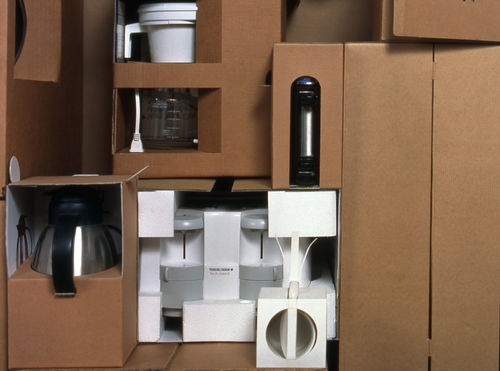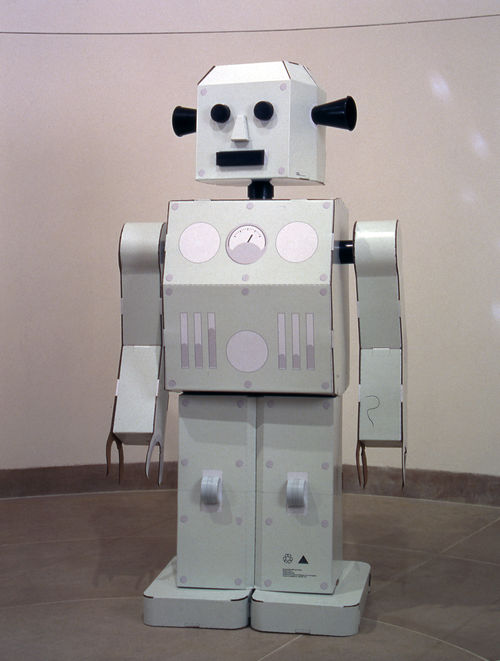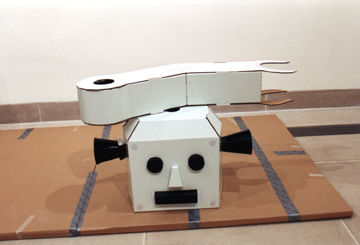
Hammer Projects: E Chen
- – This is a past exhibition
E Chen's installation is built completely from products purchased at stores, still housed in their original boxes. The boxes have been turned inside out, revealing little or no identifying colors or brands. Using objects that inhabit our daily lives and spaces, Chen creates his vision of a new consumer-driven architectural world.
Organized by Alex Farquharson, an independent curator and critic based in London, who contributes regularly to Frieze and Art Monthly.

Biography
E Chen was born in Taiwan in 1966. In 1991 he moved to California to continue his education in art and architecture. He received an M.F.A. from the University of California, Los Angeles, in 1993, and in 1996 he received a master's in architecture from the University of California, Berkeley. He has had three solo exhibitions at Richard Telles Fine Art, Los Angeles, since 1998, and his work was recently included in a group show organized by the Neue Galerie in Graz, Austria.
Essay
By Alex Farquharson
A few weeks before the opening of his installation for the Hammer Museum, E Chen's studio is full of blank cardboard boxes of various sizes. Odd parts of their contents—ordinary appliances—poke through, or can be viewed through, the one or two apertures that have been cut into most of the boxes. The bits that are revealed are the ones that interface with our bodies: the parts we grip, press, or pull. Chen has made each object generic by erasing its brand identity. He's achieved this by simply turning its packaging inside-out and refitting it around the object, generally reducing a box's volume to allow for the suggestive protrusions. Denuded of logos, lists of attributes, flattering photographs, and other exaggerated signifiers of worth, the boxes become mere structures: cubes drawn around irregular objects, with internal planes to nestle the contents in place. The boxes may be read as miniaturized units of ergonomic modern architecture. They make the objects inside resemble people in rooms, albeit squashed people in too-small rooms.
The boxed objects have other, more archaic connotations as well. The pale brown blocks suggest slabs of stone. We may imagine that these stones have been eroded to reveal entombed objects. We might try to discern the function of these objects and then, through inference, arrive at some defining characteristics of the society that made and used them. Yet these aren't potsherds, bits of weaponry, and funerary paraphernalia, but rather microwaves, jug kettles, diapers, television sets, desk lamps, and saucepans. For a moment we might forget why we have any need for them; by removing these objects from their ordinary context, Chen makes us anthropologists of our own lives.
Other, earlier installations also heighten our awareness of our habitual, unconscious bodily responses to the basic stuff that surrounds us, by stripping objects back and reassembling them in unexpected, playful ways. Chen's installation No Strategy (2000) consisted of found furniture and several thousand wooden "bricks." The bricks were stacked between, within, and around two or more tables or chairs to form single, ingenious, unusable, hybrid units. Filling the furniture's cavities, the "brickwork" evoked absent bodies. Each week during the month-long run of the exhibition, Chen would reconfigure the installation. What began as six distinct units became, in the second week, a single complex piece resembling an assault course or maze-like lower section of a house, and then, in the third, several new, discrete sections. By performing this choreography after hours, Chen made inert objects appear uncannily animated. As with the Hammer installation, it is as if we had forgotten what these things were for.
In an installation of the previous year, Chen focused on sex and produce as a means of exploring our internal, as well as external, physical relations with objects. The gallery was littered with hundreds of superrealistic colored sculptures of fruit and vegetables, some scattered about, others stacked precariously, suggestively. Amid all this were six fiberglass sculptures of pairs of pelvises and thighs sexually conjoined in different ways, as if illustrating a sex manual. They were plain, white, abstracted, and oddly unerotic. The fruit and the vegetables, by contrast, were made to appear as luscious as possible. Each one had been cast from a different fruit or vegetable the artist had consumed in the three months leading up to the show, a process used to understand the objects anew, and one that proposes the artist's body as a literal bridge between the objects and their representations.
A second strand of Chen's practice is more directly architectural in conception and process. In contrast to the sculptural explorations, these projects remain immaterial speculations. Chen received his master's in architecture from the University of California, Berkeley, and his thesis project proposed a new type of zoo for San Francisco. Rather than presenting the typical museological survey of a cross-section of species on a single site, his proposal called for ten enclosures for ten species in ten locations in the city (like kunsthalle shows). Animal types, and the architecture of their enclosures, were to be matched with human activities at a given site. The high-maintenance iguana, for example, would be housed near beauty salons in the "yuppie" district of South Park, while an aquarium for anchovies would be situated in a pizza restaurant, glass cylinders of carpenter ant colonies would sprout up in subways, Welsh black-necked goats would be stationed on precipitous Telegraph Hill, and so on.
Chen's gallery debut, Titanica (1998), was a concept for a $2 billion casino resort for the Las Vegas Strip on the theme of the Titanic disaster. A giant hand-painted twenty-four-foot billboard announced its arrival in 2001. A monitor showed a news feature about the project, with "E-Designers" (the artist's bogus employees) introducing various aspects of the program: the one-to-one scale replica ship, the three-thousand-room modernist iceberg, the "sumptuous, period-style" gaming rooms in the ship, the hourly costumed reenactments of the sinking, and excursions in lifeboats to the bottom of the resort to see a reduced-scale replica of the rusty hull as it lies in the Arctic waters today. A digital animation and an architectural drawing in Asian scroll format depicted the ship flying over the Strip and striking the Stratosphere Tower before falling, broken, onto the vacant lot just down from the Mandalay Bay resort.
Neither the zoo nor the Titanic project was conceived with a view to being built (though a casino tycoon threatened to develop the latter idea). Both, in time-honored satirical tradition, appear to accept at face value certain social norms but crank them up to a level where they begin to seem absurd or dubious, thereby exposing prevalent assumptions that usually go unrecognized or unchallenged. With the zoo this meant questioning the relations between humans and other species in our society: why it's okay to eat some animals but not others, why animals are divided into the domesticated and the wild, why there shouldn't be symbiotic relations between certain species and urban societies. Titanica, convincingly and hilariously, adopts the U.S. entertainment industry's own high production values to question its relations with history and human suffering.
The Hammer installation, entitled United Paper, includes a robot, also made of boxes, which faces the tower of inverted products. Unlike the boxed products, its boxes have identifying marks, such as diagrams for assembly and Chen's E-Design logo. The artist remarked, with caution, that the robot is a "self-portrait, perhaps" (a mechanized, branded portrait from the B-movie heyday) or that it might be a portrait of the viewer. If the robot stands for us, then the work is positioning us outside our own culture, reflecting Chen's own occidentalist perspective on California. Through his formal games and idiosyncratic fieldwork, we perceive the workings and specific cultural identities of things that are otherwise just invisibly there.
Hammer Projects are made possible by The Horace W. Goldsmith Foundation and The Andy Warhol Foundation for the Visual Arts. Additional support is provided by the Los Angeles County Arts Commission and Peter Norton Family Foundation.










